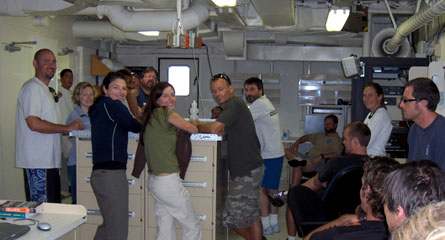|
You
are here: /main/research
expeditions/May-June 2006/Overview
May
2006 Mission Overview and
Objectives
2006
NWHI Expedition: exploring ecosystem connectivity and coral
health investigations
By Malia Rivera
On
May 18th, 2006 scientists from the Hawai‘i
Institute of Marine Biology (HIMB) and the Northwestern
Hawaiian Islands Coral Reef Ecosystem Reserve (NWHICRER), with support
from US
Geological Survey and the State
of Hawai‘i
Division of Aquatic Resources, embarked on a 25-day scientific
expedition to study ecosystems connectivity and coral health
in the Northwestern Hawaiian Islands. As part of a one year
old partnership between HIMB and NWHICRER, this is the third
research cruise aboard the NOAA Ship Hi‘ialakai, the
partnership was established to provide science based information
to help support ecosystem management in the Northwestern
Hawaiian Islands. This year, 18 HIMB research faculty, post-docs,
graduate students and research staff are onboard focusing
on three main topic areas.

The team: 20 scientists from HIMB, NWHICRER, USGS and DAR
assembled in the ships dry lab, discussing the upcoming research
expedition.
Migration
studies of apex predators including several species of
sharks, jacks and the grey snapper
Uku will continue during
this cruise. Dr. Carl Meyer is leading a team whose objectives
are to capture and surgically implant radio tags into these
migratory species and deploy complementary “listening” devices
that can detect where these large predators are moving once
they are surgically tagged. Last year, Carl set out several
of these acoustic receivers across the archipelago and on
this current voyage, he will collect nearly a years worth
of migration data that is stockpiled in those receivers.
A
similar question to the predator migration, but using a
very different type of technology, are several genetic
research
programs looking at historical connections between populations
of reef fish, coral reefs and invertebrates using DNA technology.
Led onboard by Dr. Brian Bowen, Dr. Iliana Baums and Dr.
Steve Karl, researchers are collecting specimens to bring
back to HIMB to continue work in the laboratory. Each individual
coral, invertebrate and fish sample will be isolated for
DNA and “fingerprinted” using technologies such
as microsatellite DNA markers and DNA sequence information.
By comparing individuals’ DNA profiles, indications
of population connectivity both across the archipelago and
within a coral reef can be inferred.
The
third aspect of the 2006 Expedition examines coral reef
health. Led onboard by
Dr. Greta Aeby, monitoring of reef
diseases and possible causes will be investigated both
in the field and back in the laboratory. Dr. Michael Stat
will
look at these same samples of healthy and diseased corals
in the laboratory to investigate whether certain types
of the zooxanthellae, a algal single celled symbiont living
in the tissues of corals may be correlated with bleaching
or disease resistance or susceptibility. Finally, Jennifer
Salerno is studying the types of bacterial communities
that
are associated with both normal and compromised coral tissues.
Both Michael and Jennifer’s work involves the use of
DNA technology as well, in order to identify the genetic
characteristics of the algal symbionts and bacterial communities.
This
year, Hi‘ialakai will travel to Nihoa, French
Frigate Shoals and Gardner Pinnacles, which is about midway
up the Hawaiian Archipelago. New in the 2006 NWHI Expedition
will be a trip down to Johnston Atoll, several hundred miles
southwest of the island chain. The importance of this site
results from several sources of scientific and anecdotal
evidence that Johnston Atoll may be the “source” population,
or the stepping-stone for colonization of new species to
the Hawaiian Islands. Samples collected from Johnston and
studied with DNA, disease and migration studies as compared
to the NWHI will provide insight into this important hypothesis.
Maintaining the biological and migratory connections across
the Pacific and within the Hawaiian archipelago, including
that of the populated main Hawaiian Islands, will be fundamental
to the development of an ecosystem-based management plan.
Click here to see a map of the area covered by the voyage
Click
here for other maps of the region
|